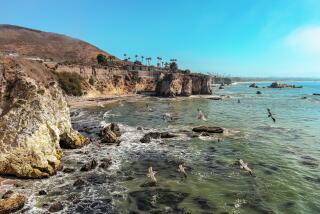Habitat Amid Humanity
- Share via
Surrounded by the bustling planned community of Irvine, there lies a 300-acre oasis of coastal freshwater wetlands, duck ponds, tall grasses and thousands of recently planted trees.
Formerly farmland and later a duck-hunting site, the once degraded marshland has been transformed into the San Joaquin Wildlife Sanctuary, a viable habitat for the imperiled California least tern, least Bell’s vireo, light-footed clapper rail and more than 200 other bird species.
For the record:
12:00 a.m. July 14, 2000 For the Record
Los Angeles Times Friday July 14, 2000 Orange County Edition Metro Part B Page 3 No Desk 1 inches; 20 words Type of Material: Correction
Bird photo--A picture that appeared July 8 on page B1 misidentified a bird at the San Joaquin Wildlife Sanctuary. The bird shown was a great egret.
The sanctuary was created by a group more likely to meet in court than at a celebration. Yet Friday morning, officials from the Irvine Co., the National Audubon Society and city and state government gathered there to mark the completion of millions of dollars in major marsh restoration work.
When the developer pledged to donate $1.5 million to the sanctuary over the next five years, the state’s top environmental leader hailed the project as a model of successful wetlands restoration and public-private partnership to be emulated across the state.
“As the cities get more crowded and more of us are hugging the coastal areas of this state, places to go walk a little bit, away from the noise and the traffic, are going to become increasingly valuable,” said Mary Nichols, secretary of the California Resources Agency.
The sanctuary is part of the 500-acre San Joaquin Marsh, the largest freshwater marsh in Orange County, which is about 70% of the size of New York City’s Central Park. The remaining 200 acres are managed by the University of California Natural Lands and Water Reserve System.
Wetlands at the site, formerly owned by the Irvine Co., were fed by San Diego Creek until the 1960s, when the waterway was channelized, cutting off the marsh’s water source and degrading much of the site. Farming in the 1950s and 1960s also polluted it. Until 1988, the land was used for duck hunting.
The Irvine Co., the Irvine Ranch Water District and the Sea and Sage Council chapter of the National Audubon Society banded together and began restoration work in 1989.
Since then, about 24,600 trees and 8,300 shrubs have been planted. Once the sycamore, cottonwood, willow, oak and other native trees mature, the high-rise buildings of Irvine will no longer be visible, said Peer Swan, president of the sanctuary’s board of directors and a water district board member.
The water district--the actual owner of the marshland--installed a pump to divert water from the San Diego Creek through the marsh, Swan said. Now, while the creek is a source of freshwater for the marsh, the wetlands act as a purification filter for the runoff-laden water. Thousands of cubic yards of sediment and tons of nitrogen and phosphorus are removed every year from the creek before they enter Upper Newport Bay about 1 1/4 miles downstream.
“What we have is an example of environmental planning that should be in textbooks for generations to come,” said Tom Mulroy of Science Applications International Corp. of San Diego, who consulted on the restoration work.
“This is a wonderful example of what we can do when we all work together,” added Sat Tamaribuchi, Irvine Co. vice president for environmental affairs. “We have created something very special.”
Wetlands are unique habitats where water meets land. Usually teeming with wildlife, coastal wetlands in Southern California provide food for migratory birds and purify runoff before it hits the ocean. Over the last century, more than 95% of the state’s coastal wetlands have been lost to development. Nichols said projects like the San Joaquin restoration are crucial because past restoration efforts have met with little success, often because of a lack of funding and cooperation.
“We have so little left,” Nichols said. “We simply have to make a last-ditch effort.”
Friday morning, dozens of terns flew overhead, ducks lazed by water’s edge and cormorants clustered on a rocky part of an island. White pelicans, geese, egrets and herons also abound at different times of the year.
Through its more than $12-million wetlands restoration work at the marsh, the Irvine Co. earned the right to develop elsewhere, such as in the Bonita Canyon area near UC Irvine. About half of the sanctuary’s acreage was restored by the developer. But local and state officials credit the developer for doing more than required, noting that about a third of the total restoration effort was not mandatory.
The site also offers recreational activities. Hikers and joggers are allowed to use about 12 miles of trails from dawn to dusk. Sea and Sage operates a bookstore and office from 8 a.m. to 4 p.m. daily except Christmas, and offers docent-led tours and runs a public education program that brings 3,000 children to the marsh.
The $1.5-million grant, $300,000 of which was presented at Friday’s ceremony, will be used to establish a trust fund. Interest on the fund is expected to pay for ongoing restoration and maintenance work.
Friday’s grant is another in a series of recent announcements of the developer’s plans to fund environmental causes. Last week, the Irvine Co. and the Donald Bren Foundation announced plans to provide $20 million for preservation and public access to open space in Orange County. Friday’s grant to the sanctuary is the first of the projects.
The announcements come about a month before the developer’s controversial housing project above Crystal Cove State Park comes before the California Coastal Commission.
(BEGIN TEXT OF INFOBOX / INFOGRAPHIC)
Urban Oasis
Endangered species such as the least Bell’s vireo and California least tern live in the 300-acre San Joaquin Wildlife Sanctuary.
More to Read
Sign up for Essential California
The most important California stories and recommendations in your inbox every morning.
You may occasionally receive promotional content from the Los Angeles Times.











